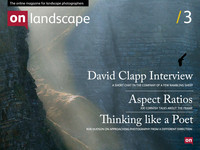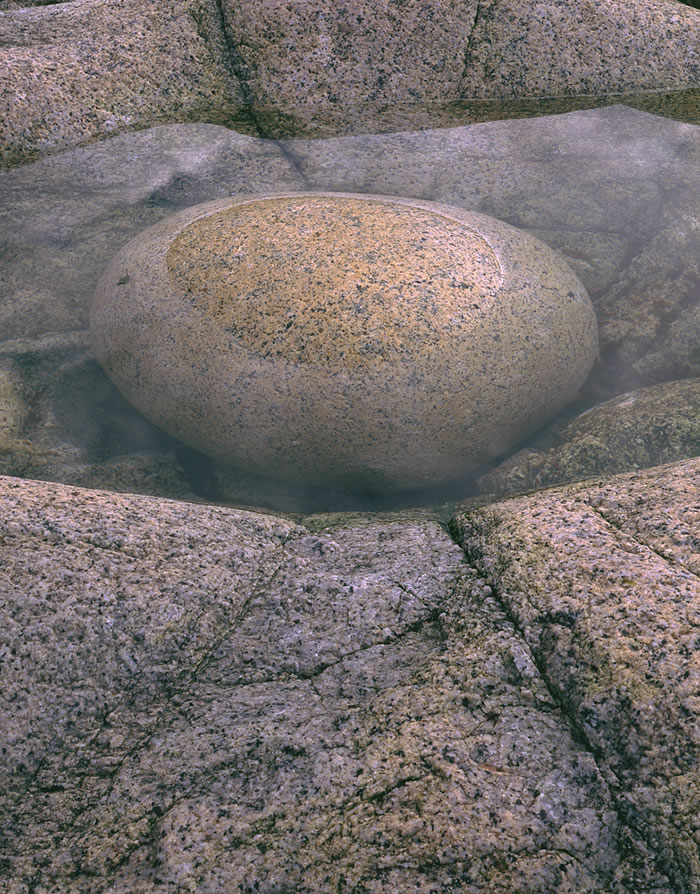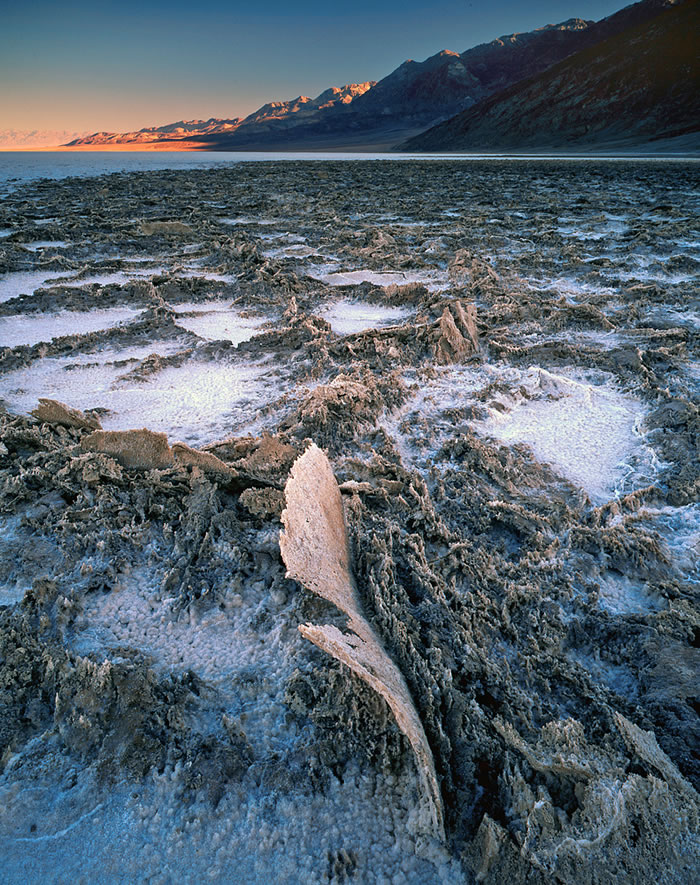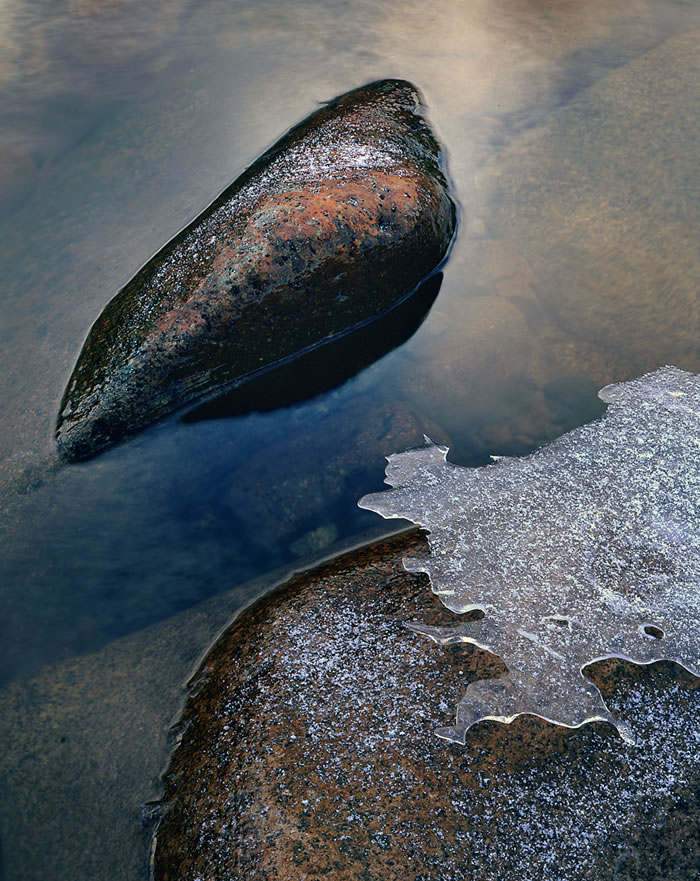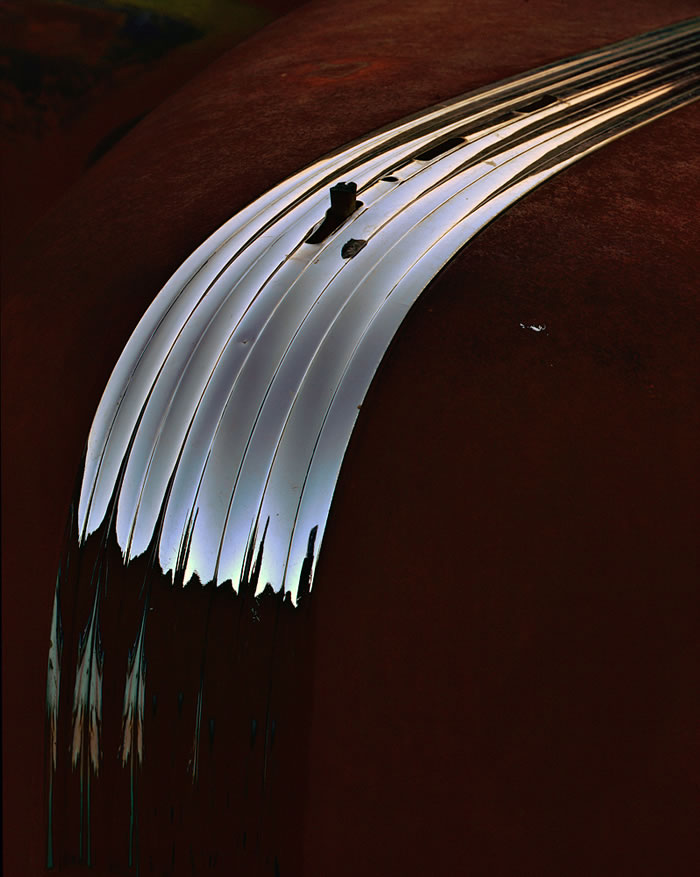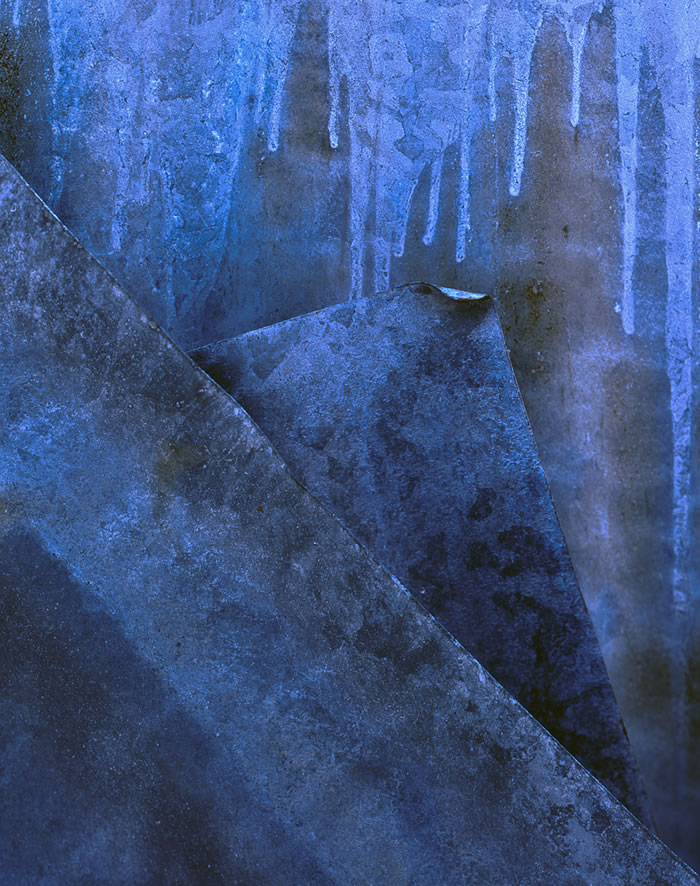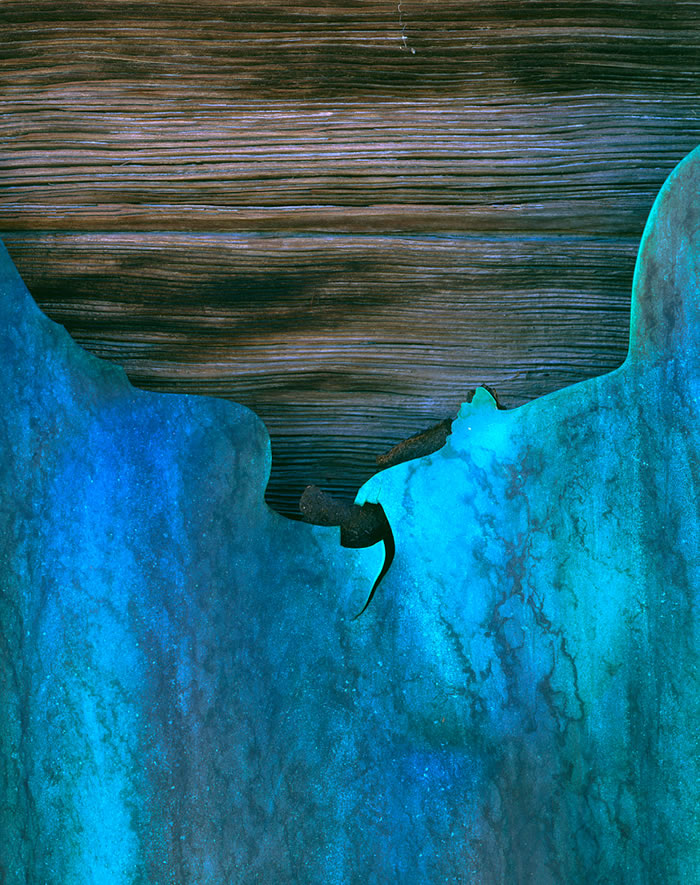Extracts from David Ward's book

Tim Parkin
Amateur Photographer who plays with big cameras and film when in between digital photographs.

David Ward
T-shirt winning landscape photographer, one time carpenter, full-time workshop leader and occasional author who does all his own decorating.
Beauty pains and when it pained most, I shot.
Ernst Haas
A debate almost as old as photography is whether we take or make photographs. I've always felt strongly that we make images, that it is a creative act. `Take' has always seemed too passive, too casual, as if the images were lying around waiting to be picked up by any passing photographer. Knowing how hard it is to produce good photographs, `take' has thus seemed to be an almost derogatory term. But I've recently realised that in one sense photography is all about taking, that it has an acquisitive side. It seems to me that when I'm looking for subjects for my photography I'm actually looking to capture their beauty; one might say that I'm seeking to drag an image of that elusive quality back to my lair so that I may feast my eyes upon it at leisure. William Somerset Maugham put it much more eloquently: ‘Beauty is an ecstasy; it is as simple as hunger.’
Only a tiny minority of photographers start solely with an attraction to the process of photography. Fascination with a subject, finding beauty in the world around us, is the motivation for image-making/taking for most photographers. The great American photographer Edward Weston wrote that he started to photograph because of ’amazement at subject matter’. I think that this childlike sense of wonder is, whether the subject is wildlife, people or landscape, the one factor that links all expressive photography. My sense of wonder as I walked amongst the hills and mountains of Britain led me to want to record their beauty, and photography seemed to me the most appropriate tool.
From wonder grows a desire to do the subject justice, maybe to reveal to others how you feel about the subject or perhaps just to make those feelings clearer and deeper to yourself. Photographs, when they are successful, can surprise even the author of the image because they reveal some hidden truth, either about the subject or about the author. Most of us will have had that `Eureka!' moment when we see an image on screen or on a lightbox for the first time and it wildly exceeds our expectations. It doesn't happen very often. Ansel Adams was probably right about his ‘twelve epiphanies in one year’, twelve times when an image seems to sing, when it appears to be so much more than the sum of its parts. But, there can be a kind of alchemy at work in the mundane chemistry and that magic seems to me to be linked to beauty.
For us as photographers, a search for mysterious beauty is also a search for the wellspring of our passion for image- making. I believe that this quality is both the motivator and an essential part of any truly great photograph. But beauty is a complicated subject – it isn't a single indivisible property but raises diverse questions, from aesthetics to psychology. Thinking about these might help us find it more readily and better understand its significance in our photography.
John Cleese once played a Renaissance Pope who had summoned Michelangelo to explain his rendition of the Last Supper. He was unhappy with the aesthetics of Michelangelo's composition and wanted to know in particular why the painting contained a juggler, a kangaroo and three Christs. Michelangelo's answer that ’the fat one balances the two thin ones’ failed to mollify him. Cleese finished the sketch by screaming in his inimitable style at a hapless Michelangelo, ’I may only be the bleeding Pope but I know what I like!’ This is a telling and amusing confirmation of Margaret Wolfe Hungerford's famous assertion that ’Beauty is in the eye of the beholder’.
The phrase highlights the most obvious quality of beauty – its particularity, the way that beauty binds one person and one object. There is a strongly weighted feeling in Western cultures that beauty is predominantly a matter of individual taste. In the English-speaking world Hungerford's oft-quoted line seems to have been at least partly responsibly for this skewed viewpoint. It has become so well known that we cannot think of beauty without it popping unbidden into our minds. The concept of beauty that she's describing is a very narrow one. It best explains beauty in relation to sexual attraction and the often unfathomable relationship between one person and the object of their desire. It's another way of saying, ‘Love is blind’.
Whilst aesthetic beauty may not be truly universal, beauty is thought of as having universal qualities. At a basic biological level, humans find bilateral symmetry beautiful. Evolutionary psychologists argue that this is because a member of the opposite sex who exhibits symmetry is more likely to be, in the evolutionary sense, fit. Certain genetic disorders and injuries or illnesses in later life result in asymmetry and research has shown that individuals exhibiting these traits are less likely to produce viable offspring. We find symmetry beautiful and the search for symmetry/beauty in potential mates is a facet of natural selection. Another aspect of beauty that is held to be universal is apparent in John Keats' famous line from Ode on a Grecian Urn:
Beauty is truth, truth beauty, – that is all
Ye know on earth and all ye need to know.
The intuitive linking of the notions of beauty and truth has a long history stretching back at least as far as Plato and the Ancient Greeks. The association between beauty and deeper meaning is not solely a Western one but seems to be cross-cultural. The Navajo, for instance, have the word `hozho’, which is normally translated into English as 'Beauty' but actually, as one anthropologist explains:
`Hozho' expresses the intellectual concept of order, the emotional state of happiness, the moral notion of good, the biological condition of health and well-being, and the aesthetic dimensions of balance, harmony, and beauty.
Despite this long-standing philosophical connection there can logically be no proof that something beautiful is inherently truthful or untruthful. Yet many scientists and mathematicians express the view that mathematical proofs or solutions to scientific problems are beautiful. The visionary, writer, architect and designer Buckminster Fuller wrote, ‘when I have finished [working on a problem], if the solution is not beautiful, I know it is wrong’.
So, beauty on the one hand is seen as being intensely personal and therefore of little account; yet on the other hand humans intuitively feel that beauty has deep and universal importance. A striking feature of the aspects of beauty that I've touched upon so far is that they seem to arise when something is fit, or rather fittest, for purpose. There is something here that seems to link the particular and universal aspects of beauty and I will return to this later in the chapter.
Given its uncertain nature why might beauty be important to photography? When Alfred Stieglitz, the man many consider to be the father of modern photography, wrote, ’Beauty is the universal seen’, he meant that humans all recognise beauty when they encounter it. A brush with beauty, however personal or universal, has a powerful effect upon viewers. They are able to relate more intimately to images that contain it. Of course, recognising beauty does not mean that we can describe it in words. The fact that you can't quantify beauty makes it richer rather than poorer.
American photographer Robert Adams (no relative of Ansel) suggested that we judge art
. . .by whether it reveals to us important Form that we ourselves have experienced but to which we have not paid adequate attention. Successful art rediscovers Beauty for us.
He also wrote:
. . . the Beauty that concerns me is that of Form. Beauty is, in my view, a synonym for the coherence and structure underlying life. . . Why is Form beautiful? Because, I think, it helps us meet our worst fear, the suspicion that life may be chaos and that therefore our suffering is without meaning.
Beauty for Adams is a universal concept that lies at the heart of what photographers are seeking to do when they create.
The beauty that Adams and Stieglitz envisage isn't the shallow veneer of appearances, it's not at all the anodyne decorative quality celebrated in beauty contests. It isn't absolute: there isn't a quantifiable highest, widest or deepest point in beauty. So how can anybody even think of having a contest? Beauty is relative, it's a quality not a quantity, and some will find it in a particular image while others will not. But the beauty that Adams refers to isn't simply a question of aesthetics. Rather it is a deeper expression of beauty that not only contains the superficial visual appeal but, critically, also reveals truths about our world. A photograph with this quality makes you see something fresh again or more importantly reveals something that you had never noticed before.
Images with this quality might be sumptuous or terrifying, they might make you happy or move you to tears. Whatever emotion they instil, the images will be compelling; beauty will force you to look at them. It is perhaps this attribute of beauty that best helps us to confirm whether it is present in an image. And isn't this what we all want from our images? We want people to take notice of our photographs because we are passionate about our subject and we have something to say.
It seems ironic to me that beauty, which humans crave in so many aspects of their lives, has been considered with disdain for almost a century within much of the realm of high art. From the early twentieth century onwards, the view put forward by over-eager Modernist artists was almost precisely opposite to that expounded by Adams and Stieglitz. In the Modernist view beauty really is only skin deep – a matter of shallow (in all senses of the word) appearances, a matter of taste and, as they sneeringly point out, inferior bourgeois taste at that! Of course there have always been exceptions but here I am discussing the entrenched orthodoxy that has formed so much of the art establishment.
The Modernists sought to apply scientific principles to art. Rather than seeing art as an aesthetic pursuit they sought to make it purely intellectual to make it an–aesthetic. Of course an-aesthetic just makes you numb and I don’t want art to numb my senses. You might say that they were merely following the social trend. In our increasingly secular Western world, we more often place faith in scientific rigour than in what we dismiss as touchy-feely notions such as beauty. However, it is only poor scientists and their imitators who hate ideas that they can't quantify, preferring absolute values to relative ones.
As modern art became increasingly inward-looking over the last century and almost completely turned its back on the natural world, so it increasingly became separated from common experience and its popularity plummeted. What more common experience do we have than the planet we live on? The problem seems to be that the most vociferous, and therefore in the eyes of the media the most influential, modern artists live along with their critics on planet Art. I use `critics' with some unease as they seem more like apologists. This is an urban world that has a very rarefied atmosphere divorced from nature. Over half a century ago Edward Weston wrote in his daybooks:
It seems so utterly naive that landscape, not that of the pictorial school, is not considered of `social significance' when it has a far more important bearing on the human race of a given locale than excrescences called cities.
So true.
To dismiss natural beauty as a source for art merely on the grounds that it isn't new is ridiculous. It is clear to me that many modern artists, especially conceptual ones, are now scraping the bottom of the barrel. The continuous search for novelty has led them into an artistic dead end. It is perhaps worth repeating the words of architect Antoni Gaudi, ’Originality is to return to the origin.’ Nothing is closer to the origin than the natural world. The natural world is held in common and offers a much wider realm than the actions of mankind. It surely can't be true that art has exhausted the possibilities for exploration and expression encompassed by the planet around us. I believe that there must be room for a middle path between the self-obsession of Modernism and the Marxist directive for art to concentrate on the social world. Surely these are just different forms of anthropocentrism, both equally and mistakenly self-centred. What's wrong with art looking at the natural world? Not the capitalised, mystical Nature celebrated by Ansel Adams et al. but simply the environments that gave birth to humanity.
For many Modernist and Postmodernist artists the manner of representation is more important than the subject – the intellectual has taken precedence over the visceral, the emotional and the decorative aspects of the image. An ugly image is seen as intellectually more successful than a beautiful one, almost irrespective of its message. This is a clear case of the triumph of style over content. In other words just what the over-eager intellectuals were seeking to avoid in the first place.
Beauty is a rare quality in our everyday lives and we hunger for it but does this mean that it will necessarily deceive us? Are we all so callow as to be overpowered by its simple presence and not to seek other levels of meaning in an image? Clearly for some this will be the case. But surely those who rail against beauty are those least likely to be swayed by appearances, those best equipped to find deeper meanings?
For me, one of the most important criteria for a good work in painting, sculpture, music or photography is that it should evoke an emotional as well as an intellectual response. Interacting with works of art should make our heart beat faster, make us feel sad or happy or wistful or depressed or whatever. . . Just make us feel!
The response might be pleasant or unpleasant but it should arise directly from the piece. The problem for all visual artists, and this applies to musicians too, is that there is no guarantee that others will feel as the artist does about their work. The emotions or concepts that the photographer is trying to convey might pass the audience by because there is no fixed meaning for a single image. Much modern art has got around this philosophical impasse by grafting on an external support structure, by explaining the imagery with words. This approach directs the viewer's interpretation more surely but also makes it more firmly an intellectual rather than an emotional experience. For my money I want art without the need for art-speak. I want my initial response to be visceral not cerebral. Intellectual enquiry can follow on but it shouldn't be to the fore.
It might seem like the pot calling the kettle black for me to accuse intellectuals of diminishing the power of art. I sincerely believe that art can blend the intellectual and the expressive but that the image should appeal to our visual and emotional senses first and foremost. The image should stand or fall on these criteria alone. Not everyone will get what the artist means but that's life! Artists will almost inevitably acquire a philosophical viewpoint on the process of making art and the messages they are trying to convey but the general audience should not need to know this in any detail in order to be able to be excited by the images. The necessity for words just shows how badly some artists have failed. I find myself in agreement with Charlie Chaplin, who opined:
I do not have much patience with a thing of beauty that must be explained to be understood. If it does need additional interpretation by someone other than the creator, then I question whether it has fulfilled its purpose.
Successful photographs, and I mean by this ones that have received both popular and critical acclaim, seem to contain some secret ingredient that is universally, if imperfectly, understood. Might this ingredient be beauty? Fred Hutchinson wrote in a critique on Postmodernism:
The postmodern arts establishment has not been able to entirely snuff out beauty. Oddly, beauty has a toughness and durability which the more fragile realm of ideas seems to lack. People still listen to Beethoven, admire Michelangelo, go to Shakespeare plays, and read Keats.
All well and good, but how does this relate to photography? Beauty is at the heart of expressive photography because it binds so many aspects of image-making together. When we manage to distil our passion into a harmonious arrangement, beauty links the emotional response of the photographer to solving the problem of composition. It also links the individual beholder (the particular) with the audience (the universal); when individual fascination achieves a wider significance it may also reveal truths hitherto untold. And all in an aesthetically appealing package, what more could one ask for?
The title of this essay was a response to Modernism's an-aesthesia and a plea to turn our back on its coldly intellectual take on art. It isn't smart to spurn beauty, it doesn't help us see more clearly; it just makes art uninspiring. I now realise that beauty never really went away. It lies at the core of our humanity and cannot simply be ignored.
Beauty itself doth of itself persuade
The eyes of men without an orator.
William Shakespeare
David Ward is one of the foremost landscape photographers in the UK. He has written extensivley about philosophy and perception in landscape photography. This is an extract from his second book, Landscape Beyond which you can purchase from Amazon. You can see more pictures at Into the Light
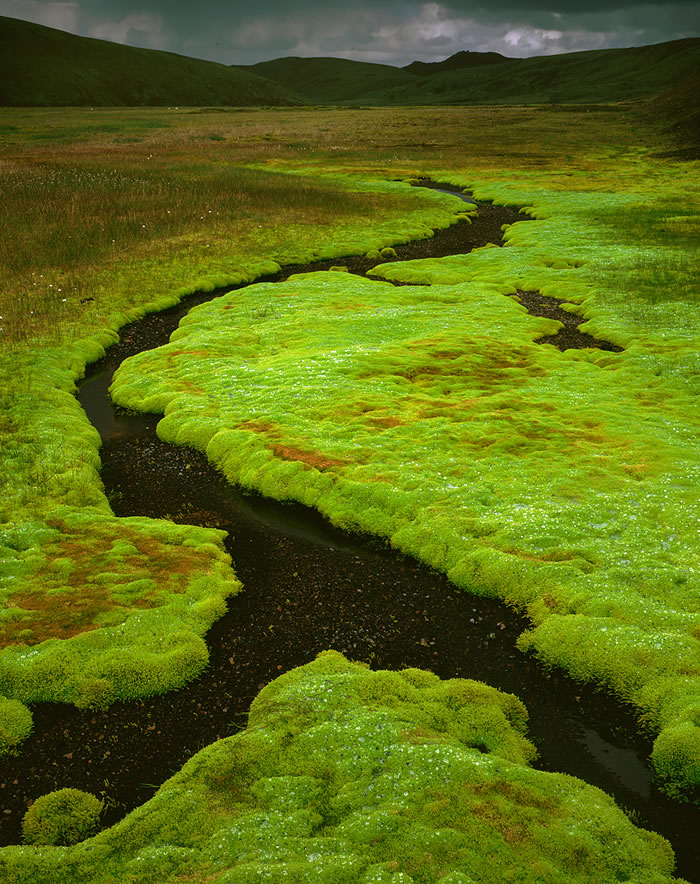
Icelandic moss

